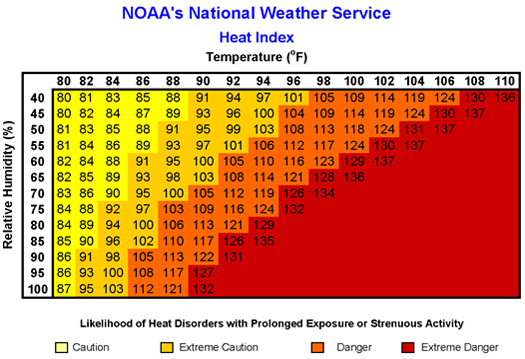Extreme Heat on the Job
Posted in Accident & Injury, Workplace Injuries and Claims on July 16, 2013
As the mercury rises, my heart goes out to workers laboring in the hot sun. They repair our roads, cut our lawns, harvest our food, and in some cases, literally provide the roof over our heads. Many of these jobs have obvious dangers, but in the summer months, workers exposed to hot and humid conditions are also at risk of heat-related injuries.
According to the Occupational Safety & Health Administration (OSHA), “Employers are responsible for providing workplaces that are safe from extreme heat, and should provide training to workers on heat-related illness and their symptoms.”
Heat Index
Both air temperature and humidity affect how hot a person working outside feels. The “heat index” combines both the temperature and humidity level into a single number. For example, if the temperature is 88°F and there is a humidity level of 60%, it would feel like 95°F. The higher the heat index, the hotter the weather feels because less sweat evaporates. This hinders the body’s natural cooling system and increases a worker’s risk of developing heat illness.
Take Heat-related Illnesses Seriously
Heat illnesses range from simple heat rash and heat cramps to heat exhaustion and heat stroke. Heat stroke requires immediate medical attention and can result in death. When heat stroke doesn’t kill immediately, it can shut down major body organs causing acute heart, liver, kidney and muscle damage, nervous system problems, and blood disorders. Workers suffering from heat exhaustion are less alert and can get confused, putting them at greater risk for accidents.
Warning Signs and Symptoms
Heat Exhaustion:
|
Heat Stroke: (Call 911)
|
Heat-related illnesses affect everyone differently, and not all symptoms may be present. Environmental factors such as working in direct sun or if there is no breeze can increase body temperature. Other risk factors include doing strenuous work, wearing bulky protective clothing, and wearing or using heavy equipment. New workers who have not built up a tolerance to hot conditions are especially susceptible to heat illness.
Water, Rest, Shade
OSHA gives this advice for beating extreme heat:
- Drink water every 15 minutes, even if you’re not thirsty
- Rest in the shade to cool down
- Wear a hat and light-colored clothing
- Learn the signs of heat illness and what to do in an emergency
- Keep an eye on fellow workers
- Gradually increase workload for new workers to build a tolerance for working in the heat
- Report any symptoms to a supervisor immediately